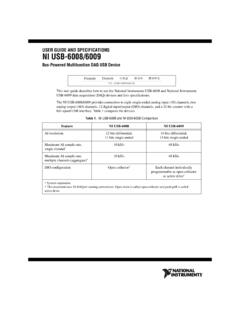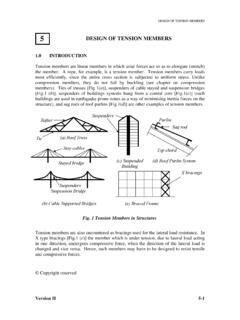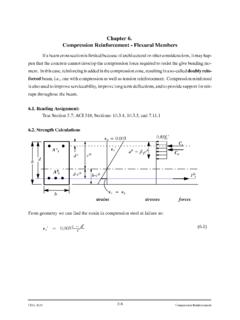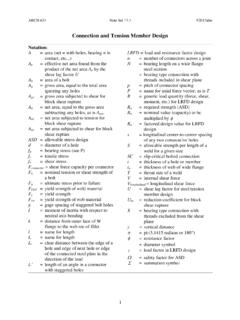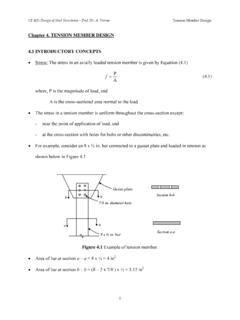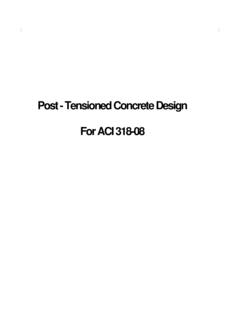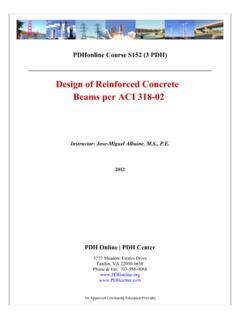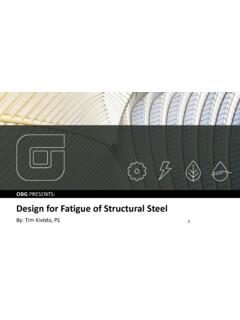Transcription of LOAD AND RESISTANCE FACTOR DESIGN SPECIFICATION
1 LOAD AND RESISTANCEFACTOR DESIGNSPECIFICATIONFor StructuralSteel BuildingsDecember 27, 1999 Load andResistanceFactor DesignSpecificationfor Structural Steel BuildingsDecember 27, 1999 Supersedes theLoad and RESISTANCE FACTOR DESIGN Specificationfor Structural Steel BuildingsdatedDecember 1, 1993 and all previous by theAmerican Institute of Steel Construction, the Direction of theAISC Committee on Specifications and approved bythe AISC Board of INSTITUTE OF STEEL CONSTRUCTION, East Wacker Drive, Suite 3100 Chicago, Illinois 60601-2001 with errata incorporated as of September 4, 2001 Copyright 2000byAmerican Institute of Steel Construction, rights reserved.
2 This book or any part thereof must not be reproduced in anyform without the written permission of the information presented in this publication has been prepared in accordance withrecognized engineering principles and is for general information only. While it isbelieved to be accurate, this information should not be used or relied upon for anyspecific application without competent professional examination and verification ofits accuracy, suitability, and applicability by a licensed engineer, architect or otherprofessional. The publication of the material contained herein is not intended as arepresentation or warranty on the part of the American Institute of Steel Construc-tion, Inc.
3 Or of any other person named herein, that this information is suitable forany general or particular use or of freedom from infringement of any patent or pat-ents. Anyone making use of this information assumes all liability arising from must be exercised when relying upon other specifications and codes devel-oped by other bodies and incorporated by reference herein since such material maybe modified or amended from time to time subsequent to the printing of this American Institute of Steel Construction, Inc. bears no responsibility for suchmaterial other than to refer to it and incorporate it by reference at the time of theinitial publication of this in the United States of AmericaLRFD SPECIFICATION for Structural Steel Buildings, December 27, 1999 AMERICANINSTITUTE OFSTEELCONSTRUCTIONiiPREFACEThe AISCLoad and RESISTANCE FACTOR DESIGN (LRFD) SPECIFICATION for Structural SteelBuildingsis based on reliability theory.
4 As have all AISC Specifications, this Specifica-tion has been based upon past successful usage, advances in the state of knowledge, andchanges in DESIGN practice. This SPECIFICATION has been developed as a consensus docu-ment to provide a uniform practice in the DESIGN of steel-framed buildings. The intentionis to provide DESIGN criteria for routine use and not to provide specific criteria for infre-quently encountered problems, which occur in the full range of structural SPECIFICATION is the result of the consensus deliberations of a committee of structuralengineers with wide experience and high professional standing, representing a wide geo-graphical distribution throughout the The committee includes approximately equalnumbers of engineers in private practice and code agencies, engineers involved inresearch and teaching.
5 And engineers employed by steel fabricating and producing com-panies. The contributions and assistance of more than 50 additional professional volun-teers working in 15 task committees are also hereby Symbols, Glossary, and Appendices to this SPECIFICATION are an integral part of theSpecification. A non-mandatory Commentary has been prepared to provide backgroundfor the SPECIFICATION provisions and the user is encouraged to consult principal changes incorporated in this edition of the SPECIFICATION include: Dual units format. Values and equations are given in both customaryand metric units.
6 The metric conversions (given in parentheses followingthe units) are based on ASTM E380,Standard Practice for Use of theInternational System of Units (SI). The equations are non-dimensionalizedwhere possible by factoring out material constants, such asEandG. Inclusion of new structural steels ASTM A913 and A992. Additional notch toughness requirements for complete-joint-penetrationgroove welds with tension applied normal to the effective area. New provisions for stability bracing of beams, columns, and frames. New Chapter N for evaluation of existing structures.
7 Revised provisions for member DESIGN under fatigue loading in SPECIFICATION for Structural Steel Buildings, December 27, 1999 AMERICANINSTITUTE OFSTEELCONSTRUCTION Reorganization of material on pin-connected members and eyebars. Revised provisions for concrete-encased beams. New limitation on the stud reduction FACTOR when a single stud is used in arib. Revised bolt bearing strength reader is cautioned that professional judgment must be exercised when data or recom-mendations in the SPECIFICATION are applied, as described more fully in the disclaimernotice preceding this the Committee,Stanley D.
8 Lindsey, ChairmanNestor R. IwankiwRoger E. Ferch, Vice ChairmanLawrence A. KloiberHansraj G. AsharRoberto T. LeonWilliam F. LewJohn M. BarsomJames O. MalleyReidar BjorhovdeRichard W. MarshallRoger L. BrockenbroughHarry W. MartinWai-Fah ChenWilliam A. MilekGregory G. DeierleinDuane K. MillerRobert O. DisqueThomas M. MurrayDuane S. EllifrittR. Shankar NairBruce R. EllingwoodClarkson W. PinkhamShu-Jin FangDouglas D. Rees-EvansSteven J. FenvesThomas Z. ScarangelloJames M. FisherDonald R. ShermanJohn W. FisherW. Lee ShoemakerTheodore V. GalambosFrank F. SowokinosLawrence G.
9 GriffisWilliam A. ThorntonJames R. HarrisRaymond H. R. TideTony C. HazelIvan M. ViestMark V. HollandJoseph A. YuraCynthia J. Lanz, SecretaryivPREFACELRFD SPECIFICATION for Structural Steel Buildings, December 27, 1999 AMERICANINSTITUTE OFSTEELCONSTRUCTIONTABLE OF CONTENTSSYMBOLS.. xvGLOSSARY.. xxiiiSPECIFICATIONA. GENERAL PROVISIONS.. 1A1. Scope .. 1A2. Types of Construction .. 1A3. Material .. Steel .. Castings and Forgings .. , Washers, and Nuts .. Rods and Threaded Rods .. Metal and Flux for Welding .. Shear Connectors .. 6A4.
10 Loads and Load Combinations .. 6A5. DESIGN Basis .. Strength at Factored Loads .. States .. for Strength .. for Serviceability and Other Considerations .. 7A6. Referenced Codes and Standards .. 7A7. DESIGN Documents .. 8B. DESIGN REQUIREMENTS.. 10B1. Gross Area .. 10B2. Net Area .. 10B3. Effective Area of tension Members .. 10B4. Stability .. 11B5. Local Buckling .. of Steel Sections .. by Plastic Analysis .. Compression Sections .. 13B6. Bracing at Supports .. 13B7. Limiting Slenderness Ratios.
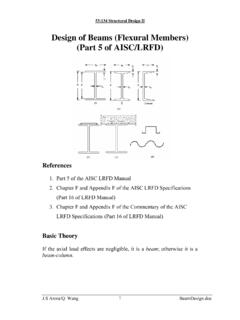

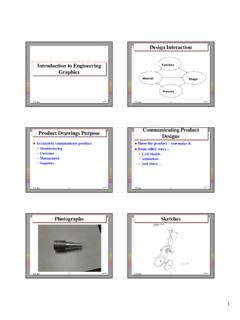
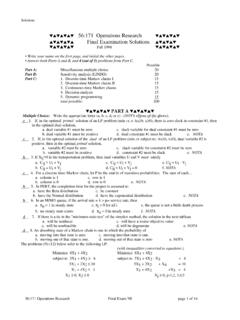
![Corrosion Protection.ppt [Read-Only] - University of Iowa](/cache/preview/1/c/f/9/2/e/d/5/thumb-1cf92ed5cf903dbf2b6cd3a840081a01.jpg)


